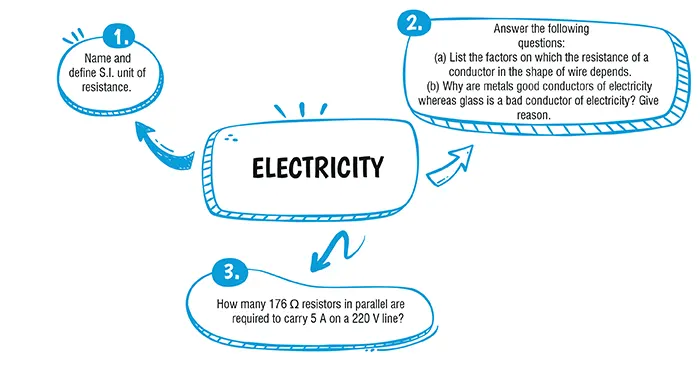

Here are some critical Chapter 11 Electricity Problems for Class 10 Science. These inquiries are intended to aid students in studying for and performing well on the CBSE Class 10 Science Examination 2023–24. Students can clear up their concerns and be ready for the exams by practising different types of questions. By answering these questions, you'll increase your confidence while also sharpening your problem-solving abilities
Chapter 11 Electricity covers Electric Current and Circuit, Electric Potential and Potential Difference, Circuit Diagram, Ohm's Law, Factors on which the Resistance of a Conductor Depends, Resistance of a System of Resistors, Heating Effect of Electric Current and Electric Power.


Ans. (b)
Explanation:
Using Ohm’s law, Current,
I = V/R
= 5/ (13+12)
= 5/25
= 0.2 A
So current flowing in 12 Ω resistance = 0.2 A
The potential difference across 12
= IR = 0.2× 12
= 2.4 V
Ans. (d)
Explanation:
E = V - Ir
V = E + Ir
\(=10+\begin{pmatrix} \frac{150-10}{18+0.8}×0.8\end{pmatrix}\)
= 15.9 V
Explanation:
The S.I. The unit of resistance is ohm (Ω).The resistance of a conductor is said to be 1 ohm if 1 ampere current flows through it when a potential difference of 1 volt is applied across the ends of the conductor.
\(1 ohm=\frac{1 volt}{1 ampere}\)
Explanation:
Resistance of a conductor depends directly on its length and is inversely proportional to the area of cross-section.
(b) Metals have free electrons and they move and conduct electricity, whereas glass does not have free electrons and charges to flow as it is an insulator.
Explanation:
Here, Potential difference, V = 220 V, Current, I = 5 A
∴ Resistance,
R =\(\frac{V}{I}\)
=\(\frac{220}{5}= 44 \varOmega\)
Let the number of 176 Ω resistors to be connected in parallel to give an equivalent resistance of 44 Ω be x.
Equivalent resistance of ‘x’ 176 Ω resistance connected
In parallel is
\(\frac{176}{x}\varOmega\)
But,\(\frac{176}{x}=44\)
\(\therefore X=\frac{176}{44}=4\)
Thus, 4 ressisters of 176 Ω each should be connected in parallel.


oswal.io offers a thorough set of questions for learning the topic in a better way if you're looking to further practise and improve your grasp of the concepts covered in the chapter.
Ans: Electric current is the amount of charge flowing through a particular area in unit time.
Ans: One ampere is constituted by the flow of one coulomb of charge per second.
1 A = 1 C s-1
Ans: A cell or a battery can be used to maintain a potential difference between the ends of a conductor. The chemical reaction within a cell generates the potential difference across the terminals of the cell, even when no current is drawn from it. When it is connected to a conductor, it produces electric current and maintains the potential difference across the ends of the conductor.
Ans: It states that the potential difference V, across the ends of a given metallic wire in an electric circuit is directly proportional to the current flowing through it, provided its temperature remains the same. Mathematically,
V ∝ I
V = RI
where R is the resistance of the conductor.
Ans: (a) (i) Tungsten is a strong metal and has a high melting point (3380°C).
(ii) It emits light at high temperatures (about 2500°C).
(b) Electric laundry iron and electric heater are based on the heating effect of electric current.